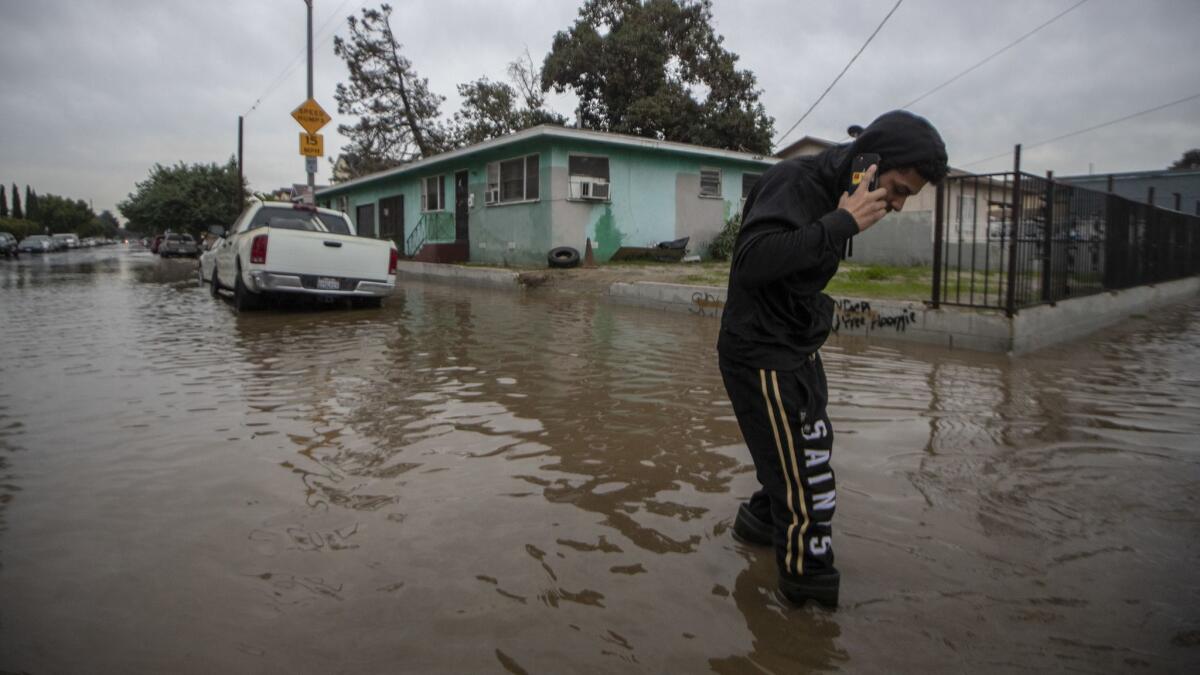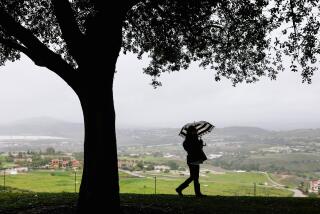Century-old water main breaks in South Los Angeles, submerging streets and cars and spurring evacuations

A broken water main flooded streets, damaged cars and forced evacuations in South L.A. on Friday morning.
A 96-year-old water main burst in a South Los Angeles neighborhood Friday, sending water bubbling up above the pavement, flooding streets and creating a void that submerged cars.
It took the Los Angeles Department of Water and Power more than four hours to fully shut off the 24-inch cast iron main as water inundated the neighborhood at 55th Street and Towne Avenue.
The break occurred just before 5 a.m. and was sealed about 9:30 a.m. Crews had to shut it off slowly, so that other pipes in the system wouldn’t burst, said Eric Shavely, a superintendent with the LADWP.
“When you have this much energy in a 24-inch water main, you have to shut it down slowly otherwise it can have some reverberations through the system,” he said.
No one was hurt, but about 20 firefighters guided residents as they waded through ankle-deep water after police raised concerns about possible damage to structures and reports of a natural gas odor in the area, said Brian Humphrey, a spokesman for the Los Angeles Fire Department.
One of the vehicles that fell into the void created by the main break damaged the gas service to one home, Shavely said. Southern California Gas Co. stopped the flow of gas to at least eight homes.
Firefighters helped a group of residents use a ladder to climb a fence as water flowed down streets and alleys. The front lawns of several homes flooded, and residents could be seen standing on their porches observing the damage.
About 30 adults and 20 children were displaced from their homes; the Fred Roberts Recreation Center was set up as a temporary shelter.
LADWP is covering the cost of hotel stays for some affected residents while crews do cleanup and repair, Shavely said. The L.A. Department of Building and Safety, which is assessing potential damage to homes in the area, has not said how long residents will be displaced. Flooding affected homes primarily on 55th Street between Avalon Boulevard and Main Street, Shavely said.
LADWP said 75 customers were without water in the area. It is not clear when service will be restored.
Crews will be working in the neighborhood probably until Monday to clean up and repair damage done by the break, but officials expect the water main to be at full pressure by 7 a.m. Saturday, Shavely said.

Workers will have to extricate the three vehicles that fell into the hole created by the main break, clean the area around the main and replaced the damaged piece with a new piece of piping, a process that can take up to 16 hours, he said.
The water main was not on the list of those identified by the agency that required replacement, because it hadn’t had any leaks until now. The district’s focus has mostly been on replacing water mains that are 12 inches or smaller because those break most often, Shavely said.
Although it is not clear what caused the main to burst, corrosion and the age of the pipe could have played a role, Shavely said.
The break provided an unsettling reminder of Los Angeles’ crumbling water infrastructure, which has been a recurring problem for years. Large sections of the water system are old and corroded, and the water district faces a continuous challenge in trying to replace the infrastructure before breaks occur.
In 2014, the rupture of a 90-year-old main sent a 30-foot geyser into the air and inundated Sunset Boulevard and part of UCLA with up to 10 million gallons of water.
Shavely said the main break in South L.A. resulted in a significantly smaller flow, but he does not know how many gallons spilled.
For years, the agency struggled to find funds to pay for the costly repair projects. In 2016, the City Council approved a water and power rate increase that is expected to provide more than $1 billion over five years, largely to be spent on system upgrades.
The water district wrote in a 2017 report that more than 29% of the city’s pipes are more than 80 years old, and the average life span of an iron water main is 100 years. The water district said at the time that “infrastructure reliability challenges are imminent.”
To that end, the agency’s plan is to invest more than $2.2 billion over a decade for infrastructure reliability projects. About $1 billion of that amount will go toward replacing main lines that have been identified as the most vulnerable, according to the report.
In 2015, the district identified 435 miles of main lines — about 6.5% of the network — that it wanted to replace. By 2017, the district had replaced 254 miles of main lines, and the number of annual leaks began to decline. The district reported 1,410 leaks during the 2016-17 fiscal year, down about 136 from 2015-16. It is not clear how many leaks have been reported this year.

alejandra.reyesvelarde@latimes.com
More to Read
Start your day right
Sign up for Essential California for news, features and recommendations from the L.A. Times and beyond in your inbox six days a week.
You may occasionally receive promotional content from the Los Angeles Times.







